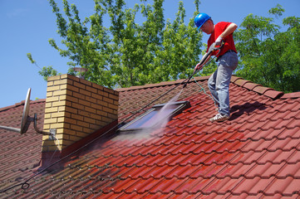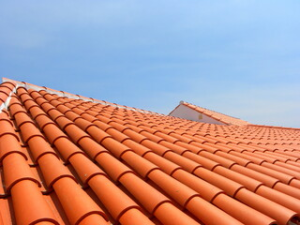Roofing Wilmington DE is a labor-intensive job that requires expertise and safety training. It can involve working at heights and navigating obstacles like chimneys and joints where roof planes meet.
Residential metal roofs are becoming increasingly popular, as they are durable and often mimic the look of slate or wood shingles. They can also provide a more energy-efficient option.

There are a number of different materials that can be used to cover a roof, each with its own benefits and drawbacks. The choice of material largely depends on a few factors, including budget and climate. Some roofing materials are not suitable for certain geographic locations, while others may not add the same amount of value to a home as other options.
Rolled roofing is an affordable option for low-slope or flat roofs, consisting of large rolls of asphalt material topped with mineral granules. It is not as durable as other roofing materials and has a lifespan of only five to ten years, but it can be a good option for sheds and garages where durability is less important.
Depending on the climate and aesthetic preferences of the homeowner, tile roofing can be made from a variety of materials, such as clay, granite, terracotta, or slate. Slate is an especially durable option that is also fireproof, resistant to high winds, and able to resist impact from small branches and hail.
Concrete tiles are heavy and expensive, but they can last for up to 200 years and are highly watertight. They are also available in a wide variety of colors and shapes, making them an attractive choice for luxury homes.
Wood shingles are a popular roofing material for traditional and modern houses, typically made from cedar or redwood. They are durable and can withstand high winds, but they do not provide as much protection against wildfires as other roofing materials.
There are also a number of synthetic roofing materials, including rubber EPDM (ethylene propylene diene monomer), thermo-polyolefin (TPO), and PVC. These are more environmentally friendly than shingles, and they can be installed in the same way as shingle roofs.
For more information about the types of roofing materials that are available, contact a local roofing contractor. They will be able to help you choose the best option for your home based on your location and aesthetic preferences. They can also answer any questions that you might have about the installation process. Choosing the right roofing materials for your home will ensure that it is protected from the elements and adds to the overall value of your property.
Any part of a house gets battered by wind, rain, snow, sunlight, and extremes of temperature, but the roof takes the brunt of it all. Whether you’re building a new house or reroofing an existing one, installing the right roof is an important process that requires a lot of attention to detail and expertise.
If you’re a do-it-yourselfer, take some time to research the roof types that appeal to you. Consider the advantages and disadvantages of each, and ask your potential roofing contractor for recommendations based on your specific needs. You can also check with the manufacturer of your chosen roofing material for a list of credentialed contractors; these roofers have undergone additional training in the installation process. Then, you can rest easy knowing your roof will provide protection and enhance curb appeal for years to come.
Any part of your home’s exterior gets assaulted by wind, rain, snow, bitter cold, intense heat and sunlight, but the roof takes the brunt of it all. A beautiful, durable roofing system that can take the beating it receives year after year is an investment worth making.
To help extend the life of your roofing, you need to perform regular maintenance on a routine basis. This includes inspections and a written record of findings and recommendations. Ideally, this should be done on a biannual basis by trained roofing professionals who are qualified to make repairs.
These inspections should focus on the regions that are most prone to leaks. This includes the areas around chimneys and where roofing planes meet. It’s also a good idea to inspect the flashing, which is a thin material installed to direct water away from these areas.
Trimming the tree branches that overhang your roof is another essential maintenance task. They can easily scrape or rip off shingles, especially if left unattended during stormy weather. It’s also a good idea that you clean your gutters and drains on a regular basis to ensure water has a clear path to exit the roof. This prevents water from pooling on the roof and causing damage. A periodic caulking of joints and seals can be very effective in preventing leaks as well. This involves removing the old caulk, then applying new.
While roofs are built to withstand various weather conditions, they’re not immune to damage. Heavy rains, hail, and wind can all cause shingles or tiles to deteriorate or even break apart. This type of damage requires quick repair or else it can lead to leaks, water stains, and structural damage in your home. Regular maintenance and timely repairs can extend the lifespan of your roof, saving you from costly replacement in the future.
Whether your roof is new or old, there are many different ways to repair it. One popular option is re-roofing, which involves covering existing shingles with new ones. However, this option doesn’t last as long as a full roof replacement and only offers a temporary fix to leaks. It also voids the warranty on the new shingles, which can cost you more money in the long run.
Other roof repairs include addressing sagging areas, replacing damaged or missing shingles, and repairing cracked flashing. Conducting routine inspections will help identify minor problems and prevent them from escalating into major issues that require roof replacement.
Another common roofing repair is adding insulation, which can reduce your energy costs by lowering the amount of conditioned air that escapes or external air that infiltrates your home. A professional roofing contractor can help you choose the right kind of insulation for your home and then install it properly to ensure that it works effectively.
Before tackling any roof repairs, make sure you have a dumpster nearby. This is because you’ll have to remove the old shingles, and that can be messy and time-consuming. You’ll also need tarps to protect foundation plantings and shrubs near the roof, as well as magnetic tools to pick up any nails or metal objects that might fall from the sky. A pro crew will probably have all this gear ready to go, so it’s worth borrowing or renting whatever you need.

